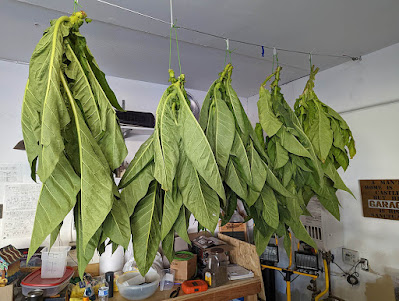Well, I've had a few pipes full of my homegrown tobacco and all three of our sons have tried it as well. This year's crop can be considered a success. Here are the things I learned along the way.
The Plants
I raised Virginians and Tennesseans. The Virginians grew tall and slender. Their leaves were stately and well-behaved, as you would expect from plants grown in Robert E. Lee's home state. In a very gentlemanly manner, the leaves ripened from the bottom up and, had I not been pressed for time because of our remodel, it would have been easy to harvest them in the proper order as they yellowed. I ended up picking most of them when they were green, but they cooperated and browned nicely in the garage.
The Tennesseans were a squat, unruly lot. They were also impossible to kill, as you would expect from tobacco grown in Nathan Bedford Forrest's native land. Their broad, plentiful leaves never ripened and I ended up hacking off the stalks at the ground when I couldn't wait any longer for them to yellow.
 |
| Tennessee tobacco refusing to brown. |
While the harvested leaves hung in the garage, the tobacco plants began growing again from the roots and soon there were hearty, new plants coming up in the back yard. Rebels, every one of them! They didn't know when to quit.
Fermentation
I tried a couple of methods of fermentation and finally found the trick. I put the leaves in Mason jars. The jars went into a plastic bin wrapped in insulation. A 60W bulb, controlled by a simple, bimetal spring thermostat, provided the heat. From time to time, I'd crank the thermostat high and let the bin get to 145, but for the most part, it averaged 120.
Some of the jars got spritzes or splashes of water to maintain the humidity inside of them. The splashes were a mistake. In fact, anything more than a spritz or two was a mistake. The more water I added, the more boiled collard greens I made. Two big jars of the Tennessee were effectively ruined in this way. Cranking up the humidity is highly overrated. My bet is that the leaves brought plenty with them.
Smoking
Our oldest son and I tried the first pipes up in Seattle. It turned out that the fermented tobacco was too moist and wouldn't stay lit. He had a real brain wave and put the leaves into his toaster over to dehydrate them. He also crushed the dried leaves and removed all the stems and veins. Properly prepared, the tobacco was jammed into our pipes and lit.
Smoking a pipe takes some experience. I finally learned to light it and then puff a few times on it to get the bowl going. Once it was, you could take drags at your leisure. Each bowl required two to three lightings to get all the way through.
Oldest and middle sons said they got a tobacco rush from it, but not know what that felt like, I'm not sure if I did or not. I do know it was a lot of fun to sit in the back yard, sipping Alabama whiskey and smoking home grown tobacco with the boys.
Worth A Repeat?
I'd say yes. Now that I know how to ferment the stuff, I won't have to grow 25 plants, I can grow nine or ten. I ruined almost all of the Virginia with my initial fermentation failures.
As for which variety, well, that's a tough one. In Seattle, it seemed like the Virginia was clearly better. Here in San Diego, a different selection suggested that the Tennessee was better. I think that to have a fair comparison, I'd need to do it again next year and be much more careful with the harvesting and fermentation in order to get a good reading.
Wow. With the quantities you have, there is no need to restrict it to a pipe. You could fill a bee smoker with it, and have enough for everyone in the room!
ReplyDeletehttps://en.wikipedia.org/wiki/Bee_smoker
(bee smokers are great for generating smoke from moist material. I usually start mine with some wood chips that I burn down to a charcoal bed, and then feed it with green grass to generate smoke. Lots of smoke.)
For that matter, maybe you could install an "electric start" in your pipe. A little loop of nichrome wire connected to a battery ought to keep things going no matter how damp it is.